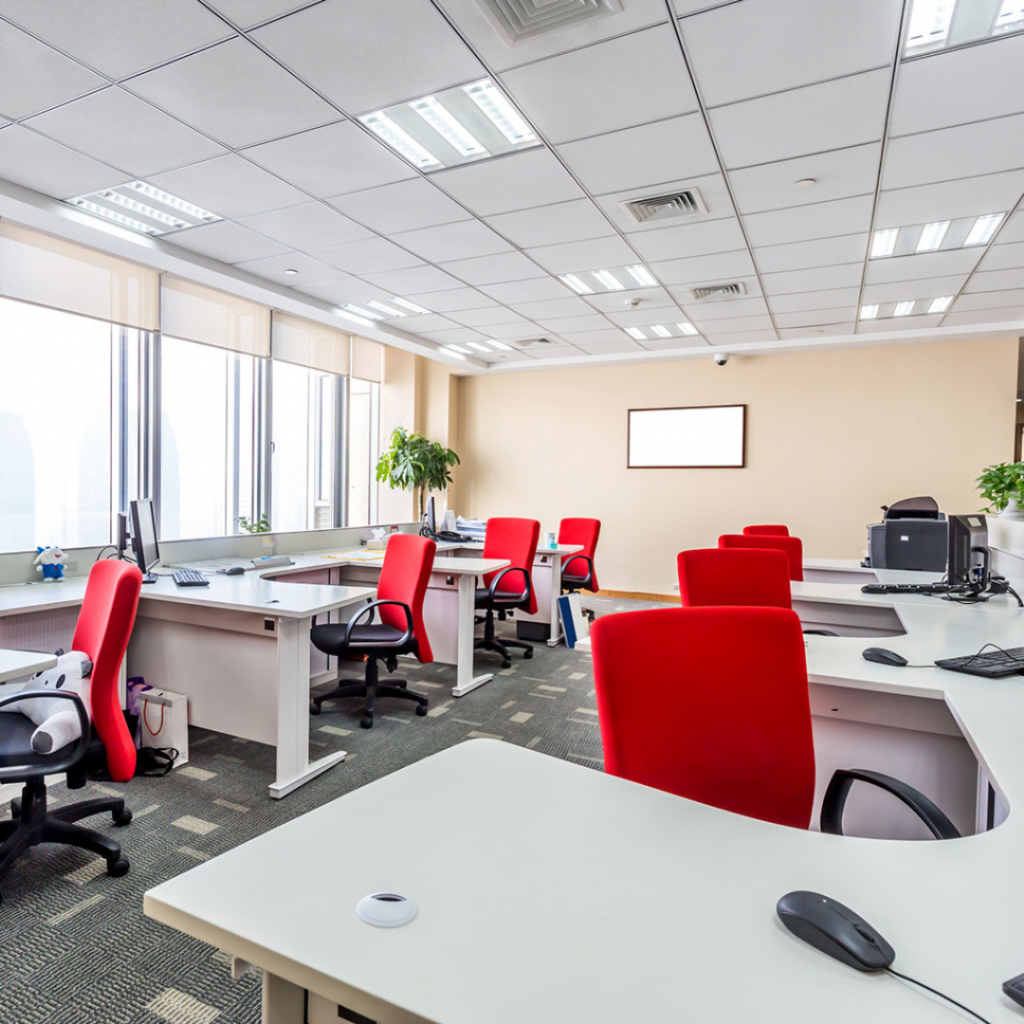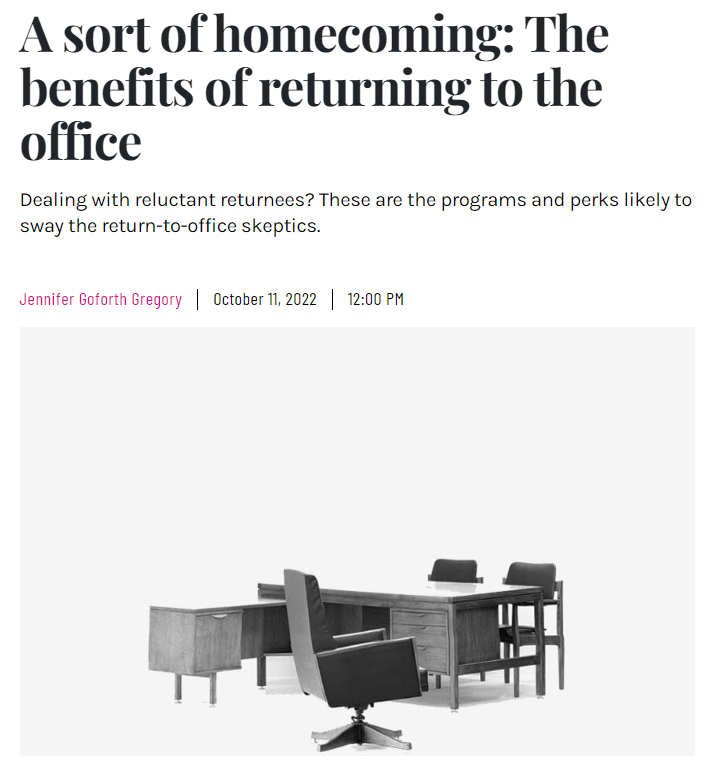Dealing with reluctant returnees? These are the programs and perks likely to sway the return-to-office skeptics.
Original Article Here
Almost every office looks very different today than it did three years ago, both in terms of the number of people who are physically present and the tasks they perform while on site. The problem: Amid the tectonic pandemic-era shifts to flexible work arrangements, many organizations have failed to persuasively rearticulate the benefits of office life.
Indeed, any number of leaders of medical marketing organizations openly admit that they are struggling to recapture their pre-pandemic office culture — which isn’t to say that they aren’t trying. According to Envoy’s At Work: 2022 Workplace Trends report, 88% of companies are using incentives to get their workers back into the office.
Based on conversations with a host of industry leaders and HR execs, here’s what organizations need to do in order to make their people truly want to be physically present on a regular basis. You’ve seen the sticks (read: mandates); these are the carrots.
Offer the right incentives
Yoga sessions and end-of-week happy hours are so common at this point that they no longer hold any particular allure. That’s why employers must get creative and find more unusual incentives and perks to offer their people.
The catch? The wrong perks can push people even further away. The New York Times recently came under fire for giving its people branded lunch boxes as an incentive to return to the office. Rather than “cute trinkets,” employees said they wanted the organization to help them address the challenges they are facing, such as rising inflation, high gas prices and sharply rising interest rates.

Help employees care for their pets
Companies have long helped their people care for children and other family members. It might be time to expand that support to include pets.
The American Society for the Prevention of Cruelty to Animals reported that more than 23 million U.S. households — almost one in five — adopted a pet during the pandemic. As people return to the office, leaving these pets alone all day has emerged as a huge concern. To that point, Blackhawk Network found that 23% of people want to work from home in order to spend more time with their pets.
Crawford Thomas Recruiting president William Stonehouse notes that many organizations are now offering stipends for doggy daycare or pet-sitters. Other companies are taking it a step further and welcoming pets into the office so they can continue in the co-worker role they’ve performed for the past three years.
“These benefits help alleviate a big concern for people returning to the office whose attachment to their pets has gotten stronger during the pandemic,” Stonehouse notes. “This is also a perk that is unique and one that most employees’ or candidates’ friends or families don’t have. Being pet-friendly shows compassion in a way that helps project your company culture.”
Address the cost of commuting: After years of saving money previously directed toward commuting costs, employees have experienced sticker shock in the form of gas, tolls, train tickets and other traveling-related expenses. When the Conference Board found that 33% of in-office employees are concerned about the increased commuting times and costs, the only surprise was that the percentage wasn’t any higher.
Stonehouse is seeing more companies move to address such considerations. His own company, he reports, increased parking stipends for some urban office locations.
VMLY&R Health is similarly offering deeply discounted parking at a nearby garage. Co-lead North America and chief client officer Jason Gloye notes that because a lot of people moved out of New York City during the pandemic, knowing that they have a safe and affordable place to park makes it easier for them to come into the office.
Heartbeat is taking a different approach. If an employee goes into the office even once a month, she is eligible for a $100 commuting stipend.
“One Heartbeat employee didn’t want to come back at all, which we totally support with our Work from Wherever Forever policy,” says Heartbeat VP, human resources and operations Michelle Edwards. “But many of us have real relationships with each other. When someone comes into the office even once, they realize how much they miss seeing each other and often come back more often.”

Fill up the events calendar
Events are clearly not a new phenomenon at medical marketing organizations. But unlike before the pandemic, their purpose has expanded beyond general employee engagement. A more thoughtful approach to events is needed.
“We hear from employees that they don’t want to commute to just sit in an office all day and do their work,” says Real Chemistry chief communications, culture and purpose officer Wendy Carhart. “But they love coming in if there is a reason, such as an event, a great brainstorm planned or a team member visiting from out of town. We are social creatures, so we work to get people gathered with good energy in the office, which really makes a difference.”
Carhart reports that Real Chemistry has received positive feedback about themed activities, such as its activities around Hispanic Heritage Month. The company brought in speakers to discuss health disparities in Latino communities and celebrated the culture with a pot luck lunch featuring staffers’ favorite homemade traditional Hispanic dishes.
AbelsonTaylor, for its part, has rallied its people around in-office Wednesdays, offering employees multiple lunch options and the opportunity to meet new colleagues (the company’s new people generally start on Tuesdays). It has also staged multiple events on Wednesdays, according to senior director of workplace experience Kristine Adams. “Petals & Pints,” for example, gave staffers the opportunity to create handmade bouquets and sample floral-inspired ice cream pints.
The problem is that it’s easy for events to start to feel like an obligation, which is the precise opposite of what pandemic-scarred employees want. Stonehouse recommends asking employees to delineate between the events that are motivating and enjoyable, and the ones that are a chore.
“In the past, people attended events without thinking about it. But now, organizations need to be more thoughtful when scheduling events,” says Stonehouse. “People feel like they have more choice and put more value on their time. Events need to be something that employees are interested in attending.”

Rethink your physical dimensions
During the pandemic, Spectrum Science tripled its workforce, from 100 employees to 300. At almost any other time in the last 75 years, leaders would have responded by going out and finding more office space. Spectrum’s leaders instead decided to use its existing space in different ways.
Now that many people come into the office with a specific purpose in mind (usually a structured meeting), Spectrum decided to reevaluate its collaboration and conference room spaces. Company president Michelle Gross notes the newfound importance of making sure all potential eating areas are as inviting as they can be. Every time she visits one of the agency’s offices, she says, she finds the liveliest informal conversations taking place in the kitchen or in the nearby lunch booths.
Needless to say, many employees developed new work habits during the pandemic. While working at home, they moved out from behind their desks to whatever location was most comfortable and productive at a given moment — the couch, the patio, you name it. Office spaces need to be rethought with this in mind.
“Not everyone needs or wants to sit at a desk with a phone and two giant monitors to do their job,” Stonehouse says. “People don’t want to feel like they are chained to their desk. They want the flexibility.”
Several of VMLY&R’s offices have outdoor terraces and courtyards. Each of its locations also has multiple “soft spaces” with couches and bean bag chairs. Conference rooms include both traditional tables and couches, to create seating flexibility.
Stonehouse says many companies are taking this same comfort-first approach. The goal is to recreate the feeling of being at home — and maybe even prompt people to forget that they’re in an office setting.
Retain a focus on workplace culture
While it’s easy to concentrate on the logistics of getting people back in the office, the smartest leaders are instead working on strengthening organizational culture by creating a unique, low-key office vibe.
It doesn’t hurt to involve employees in the bigger-picture decision-making process, especially when their comfort and sense of belonging is involved. Real Chemistry instituted a competition around rethinking its physical space, with the winning team proposing a redesign of the common areas away from individual workspaces as well as an annual company retreat.
Ultimately, according to Edwards, it comes down to presenting a broad slate of opportunities for those who want to come in and join the fun — and, in doing so, giving wary workers the sense that they control their own destiny. A cultural resurgence should follow.
“Before COVID, you felt our culture when you walked through the door,” says Edwards. “You could feel the camaraderie, laughter, smiles and energy. Culture is a strength and we want to keep it going for the future.”

Follow our Recruiter Blog and Social Media:

